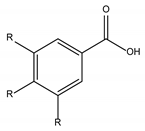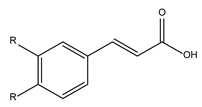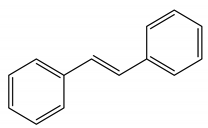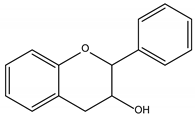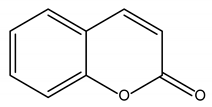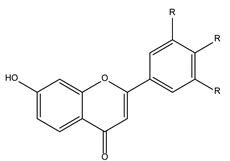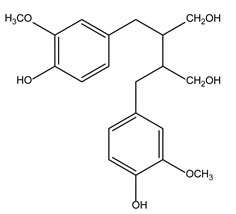2. Wine By-Products—Chemical Composition and Bioactive Compounds
There is an increased interest in the valorization and use of by-products generated at the different stages of wine production, fueled by the trends of sustainable agriculture and the consumers’ preference for natural materials. As shown in , winemaking by-products are rich in bioactive secondary plant metabolites belonging to different phytochemical groups (alkaloids, terpenes, antibiotics, volatile oils, resins, cardiac glycosides, tannins, sterols, saponins, and phenolics)
[19][44]. They can, therefore, be valorized into a wide range of products of industrial interest, such as food additives, nutraceuticals, ingredients of foods/dietary supplements, medical remedies, fertilizers, animal feed, antimicrobial components, cosmetics, and biomass for biofuels
[5][20][30,45]. Secondary metabolites are organic molecules that plants produce in response to external stressful conditions (e.g., unfavorable environment, nutrient deficiencies, pest attacks)
[19][44], and that are not essential for their life and growth
[21][22][22,46]. Rather, secondary plant metabolites (SPMs) have defensive roles and participate in interspecies competition
[21][22]. The multiple bioactivities of SPMs make them important sources of molecules for pharmacological applications
[21][23][22,47].
Figure 1.
By-products generated during the winemaking process and their composition.
Polyphenols are one of the most abundant bioactive SPMs, representing ca. 70% of the bioactive compounds found in fruits
[24][25][48,49]. Besides their action as plant hormones, inhibitors of enzymatic reactions, and plant growth regulators, they exhibit important properties regarding their potential for industrial use; antioxidant, antiallergenic
[26][50], anti-inflammatory
[27][51], anticarcinogenic
[28][29][52,53], antihypertensive
[30][54], and antibacterial
[31][55] activities have been described in this class of compounds. Phenolic compounds are formed by an aromatic ring bearing one or more hydroxyl substituents and may range from simple phenolic molecules to highly polymerized molecules. They can be divided into two main classes on the basis of their chemical structure, number of aromatic rings, and their binding affinity for different compounds
[25][49]: flavonoids and non-flavonoids. Flavonoids, the most abundant polyphenolics in grapes
[32][56], can be further divided into five subclasses: anthocyanidins, flavonols, flavan-3-ols, flavones, and chalcones, depending on the degree of oxidation of the central pyran ring. Non-flavonoids include phenolic acids (hydroxybenzoic acids and hydroxycinnamic acids), stilbenes, coumarins, and lignans ()
[33][2][34][2,24,57].
The main by-product of the winemaking industry is grape marc (or grape pomace), that is, the solid organic material that remains from the crushing, draining, and pressing processes. It consists of a mixture of grape stalks/stems, skins, and seeds. It is considered to be the most abundant winemaking by-product—it is estimated that 6 L of wine generates 1 kg of grape pomace, corresponding to 20–30% of the original grape weight [25,29,30,45]. Vast amounts of grape mark are, therefore, available in wine-producing regions of the world and disposing of them constitutes an important environmental issue. Little thought is, however, given to its potential as a source of commercially valuable products [45,58]. The chemical composition of marc can be affected by environmental (climate, soil type) [25,29,59] and viticultural factors (fertilization, defoliation, grape variety, maturity, and harvest time) [59,60], as well as by grape processing techniques employed during winemaking [59]. Whereas red wine undergoes a fermentation process, the musts are removed before alcoholic fermentation in the other wine varieties. Therefore, the fermentable sugars remain in their pomaces [29]. The composition of white grape extracts, in general, is not considerably distinct from that of the extracts of red grape cultivars, except for lower concentrations of polyphenols, particularly, a low or non-detectable amount of anthocyanins (the compounds that are responsible for the red pigmentation in grapes) [61]. Thus, the compositional differences reported by Venkitasamy et al. [29] are possibly due to the difference in the winemaking processes used. Overall, the composition of marc is complex; it contains 30% neutral polysaccharides, 20% pectic acid derivatives, and 15% insoluble proanthocyanidins, lignin, proteins, and phenols [25,29,30,62,63]. The high polyphenol content is one of the most important characteristics of grape marc, due to the pharmacological properties of this fraction, which includes resveratrol, procyanidins/condensed tannins, anthocyanins, flavanols, flavonol glycosides, phenolic acids, alcohols, lignans, stilbenes, and flavanols/catechins. Protocatechuic acid is the most dominant phenolic acid in grape pomace and the main flavonol is quercetin-3-O-glucuronide [29,45,64]. Each of the main components of grape marc—skins, seeds, and stalks/stems—has a characteristic constitution, with some presenting a more favorable composition than others, regarding their bioactive potentialities [45,58].
Grape skins are generally regarded as one of the major components of the grape pomace
[20][40][45,62]. In red pomace, they correspond to 52–56% of dry matter and in white pomace to 17–28% of dry matter
[40][62]. Phenolics are located in the inner layer of the skin, which contains the largest amount of anthocyanins and tannins with a higher polymerization degree, but a lower amount of gallates when compared with other grape pomace components
[43][65]. The major phenols present in grape skins are flavan-3-ols, anthocyanins, flavonols, hydroxybenzoic acids (protocatechuic and gallic acid are the most dominant), stilbenes, and hydroxycinnamic acids. Anthocyanins are mainly found in skins, the most abundant being malvidin-3-O-glucoside, followed by peonidin-3-O-glucoside. The skins also present neutral polysaccharides (20% cellulose and 12% hemicelluloses), 20% of acidic pectin substances, 15% insoluble proanthocyanidins, 2–8% of ash, 5% of extractives soluble in dichloromethane, and 5–12 % structural proteins
[40][42][44][45][62,64,66,67].
Grape seeds are another of the major industrial winemaking by-products; they represent 38–52% of grape pomace on a dry matter basis and about 5% of the grape weight
[46][68]. Each year, the winemaking industry discards, worldwide, an estimate 3 Mton of grape seeds
[40][62]. Their chemical composition depends on a variety of factors, such as climate, soil, grape variety, and degree of ripeness. Grape seeds have a high content of fiber (40%
w/
w), proteins (11%
w/
w), lipids (fats and oil; 16%
w/
w), polyphenolic compounds (7%
w/
w, such as tannins), carbohydrates, and minerals
[15][47][40,69]. Grape seeds extracts are rich sources of linoleic acid and bioactive polyphenols, such as resveratrol and oligomeric procyanidins. Epicatechin, catechin, and gallic acid are the major polyphenols in grape seeds. Regarding the non-flavonoids, phenolic acids (caffeic, gallic, protocatechuic, 4-hydroxybenzoic, and syringic) are the most prevalent
[4][40][48][49][29,62,70,71].
Grape stalks are the framework of the grape raceme that is removed before the vinification process. They represent 14% in weight of the total wine solid wastes and 3–5% of the raw matter of the processed grape
[45][67]. The chemical composition of the stalks is characterized by the presence of lignocellulosic materials, with 17–26% lignin, 20–30% cellulose, 3–20% hemicelluloses, and 6–9% ash
[44][66]. Stalks are also characterized by the presence of tannins that are associated with lignin with a higher condensation degree than other lignins from other ligneous residues
[45][50][67,72]. Polysaccharides comprise more than 50% of the grape stalks. The most abundant of the extracted monosaccharides are glucose and xylose, while mannose, arabinose, and galactose have been extracted in minor quantities. As observed in the other grape by-products, the concentration of these compounds in stalks depends on several factors
[40][45][50][62,67,72]. Grape stalks/stems contain around 6% of phenolic compounds on a dry weight basis. The main phenolic compounds are flavan-3-ols, hydroxybenzoic acids (gallic and syringic acids), flavonols (quercetin derivatives, such as glucuronide, glucoside, galactoside, and rutinoside), and stilbenes. Tannins represent approximately 80% of the phenolic compounds in grape stalks
[42][45][51][64,67,73].
Grape leaves have a diverse chemical composition and high content in phenolic compounds. With regard to their chemical composition, they contain organic acids, flavonols, tannins, anthocyanins, lipids, enzymes, vitamins, and sugars
[42][64].
3. Wine By-Products as a Source of Compounds Possessing Antibacterial Properties
Natural products are still an important source of alternative antimicrobials
[52][53][54][55][16,74,75,76]. In particular, plant polyphenols may offer promise in this respect
[33][2][56][57][2,24,77,78]. Besides their well-documented antibacterial properties
[49][58][71,79], subinhibitory concentrations of polyphenols—either in their purified form or as polyphenol-rich plant extracts—can also enhance the activity of antibiotics when used in conjunction with these drugs, rendering formerly resistant bacteria sensitive and decreasing the antibiotic dose needed to kill or inhibit a pathogen
[53][74].
The mechanisms underlying the antibacterial activity of polyphenols are not yet fully understood. Polyphenols are thought to target several bacterial cell constituents (cell wall, cell membrane, bacterial proteins, bacterial adhesion structures), interfere with bacterial metabolite and ion equilibria, impair the proton gradient required for oxidative phosphorylation, inhibit biofilm formation, and interfere with nucleic acid synthesis and with the regulation of gene expression
[33][59][2][60][2,18,24,80]. Furthermore, they may attenuate virulence
[61][81]. The bacterial cell wall seems to be the main target for the antibacterial action of phenolic compounds
[62][82]. They compromise cell wall integrity, leading to increased permeability and deformation of the cell
[60][80]. The outer membrane present in the cell wall of Gram-negative bacteria may hinder polyphenol uptake; therefore, Gram-positive bacteria may appear more sensitive than the Gram-negative bacteria
[56][63][77,83]. The cell membrane is another important target for some polyphenols (e.g., ellagitannins, catechins, non-lignans). Some have high affinity for bacterial membranes, particularly for those of Gram-positive bacteria, affecting membrane thickness and fluidity, and increasing its permeability
[59][60][64][65][18,80,84,85]. Polyphenols are also capable of bonding covalently and non-covalently (hydrogen bonds, hydrophobic interactions, van der Waals attractions) with important bacterial proteins, such as penicillin-binding proteins (PBPs), transporter proteins, surface-adhesion proteins, membrane-bound enzymes, and cell-wall polypeptides. The interaction polyphenols–PBPs is of special importance for their potentialities as antibiotic adjuvants
[60][80]. Certain polyphenols can modulate bacterial gene expression, thereby causing major metabolic changes. The exact mechanisms of this modulation are not yet known; it may be achieved either by direct interaction with the bacterial DNA or by epigenetic mechanisms (modulation of the activity of transcription factors
[60][80]. Additionally, polyphenols inhibit several enzymes involved in nucleic acid synthesis (topoisomerases, gyrases, and helicases), a property that significantly contributes to their antimicrobial activity
[59][18]. Polyphenols can modulate the concentrations of essential bacterial metabolites, impair ionic strength equilibria, and weaken the proton gradient, thereby killing the target bacteria
[65][85]. Bacterial biofilms allow bacteria to persist in the environment and take part in their pathogenic activity
[66][86]. Polyphenols have been proven effective against bacterial biofilms
[60][67][80,87]. These compounds influence biofilm establishment and maturation by interfering with bacterial adhesion, motility, and quorum sensing
[59][18]. One potential application of polyphenols with antibiofilm properties is in the treatment of urinary tract infections
[60][80]. They may also prove useful in the prevention of biofilms on the surface of medical devices
[67][87]. Phenolic compounds can act as antioxidants due to the presence of free -OH groups, which inhibit the generation of reactive oxygen species and scavenge free radicals, thus decreasing the redox potential and affecting microbial growth
[68][13].
The antibacterial activity of polyphenols depends on their chemical structure and it seems to be related with the presence of the 3,4,5-trihydroxifenyl group
[2][24]. Polyphenols are a diverse class of molecules, with differences in the structure of their carbon framework, presence of glycosidic bonds, and number, position, and alkylation of OH groups
[62][69][70][71][72][73][82,88,89,90,91,92] that account for the differences in their antibacterial activity. The antibacterial spectrum of polyphenols, as a class of molecules, has been reported to encompass both Gram-negative and Gram-positive bacteria
[58][79], albeit the former have been touted as less sensitive to their action
[63][83]. Antibacterial activity against antibiotic-resistant and non-antibiotic resistant Gram-positive bacteria has been demonstrated in several polyphenols (phenolic acids, flavonoids, tannins, lignans, and stilbenes) and their combinations
[60][80]. The sensitivity towards individual phenolic compounds is not only species but also strain dependent
[63][83]. Mixtures of polyphenols, such as those present in plant extracts, appear to have a stronger inhibitory activity than individual compounds
[56][77].
Several studies have demonstrated the antibacterial potential of extracts from winemaking by-products (WBPEs)
[73][74][75][76][77][78][79][80][81][82][83][84][85][86][87][88][89][92,93,94,95,96,97,98,99,100,101,102,103,104,105,106,107,108]. The phenolics that are responsible for the antimicrobial activity in winemaking by-products are phenolic acids, quinones, saponins, flavonoids, tannins, coumarins, terpenoids, and alkaloids
[33][68][2][2,13,24]. However, there is a wide structural variation among the major bioactive compounds, and this can result in differences in their antimicrobial action, as discussed above.
presents an overview of the studies on the antibacterial activity of WBPEs. The paucity of studies concerning the antimicrobial activities of WBPEs and the diversity of methodologies they employ complicate attempts to derive broad conclusions from their analysis. Inhibitory activity against a broad range of Gram-positive (
Bacillus amyloliquefaciens,
Bacillus brevis,
Bacillus cereus,
Bacillus coagulans,
Bacillus subtilis,
Clostridium septicum,
Enterococcus faecalis,
Enterococcus faecium,
Listeria monocytogenes,
Mycobacterium smegmatis,
Staphylococcus aureus, and
Staphylococcus epidermidis) and Gram-negative bacteria (
Aeromonas hydrophila,
Campylobacter coli,
Enterobacter aerogenes,
Escherichia coli,
Klebsiella pneumoniae,
Proteus vulgaris,
Pseudomonas aeruginosa,
Shigella sonnei, as well as the Enteritidis, Infantis, Poona, and Typhimurium serovars of
Salmonella enterica)
[73][74][75][76][77][78][79][80][81][82][83][84][85][86][87][92,93,94,95,96,97,98,99,100,101,102,103,104,105,106]. Interestingly, WBPEs were active against multi-resistant strains in some cases
[80][85][99,104] and activity was also observed against bacteria that have passive mechanisms of antibiotic exclusion, like the spore protective layers in sporulated genera (
Bacillus,
Clostridium)
[75][76][78][79][80][83][84][85][86][87][94,95,97,98,99,102,103,104,105,106] or the cell wall of acid-fast bacteria (
Mycobacterium)
[78][89][97,108]. In some studies, a broader inhibitory spectrum and/or lower minimum inhibitory concentrations (MICs) were found against Gram-positive bacteria rather than against Gram negatives
[88][107]. Frequently, WBPEs (e.g., seed extracts) are bactericidal
[89][108]. The minimum inhibitory concentrations (MICs) presented in . vary widely, reflecting not only the resistance/sensitivity of the target bacteria, but also several factors that influence the type and concentrations of the individual phenolics present in the extracts.
Table 2.
Grape by-products as antimicrobials.
When it comes to the antimicrobial activity of WBPEs, there are several factors to be considered. Extraction solvent, extraction procedures, pomace fraction, and grape variety have been found to affect the yield, polyphenolic composition, and antimicrobial activity of the extracts
[77][86][96,105]. The bactericidal effect of extracts was demonstrated to be dose dependent, but often lower concentrations were also inhibitory
[75][78][79][84][87][94,97,98,103,106]. Studies comparing the type of solvents used
[75][78][94,97] have found that acetone:water:acetic acid(90:9.5:0.5) extracts had higher inhibitory activity than methanol:water:acetic acid (90:9.5:0.5) extracts. However, WBPEs obtained with other solvent systems also displayed antimicrobial activity, as shown in . Grape variety seems to affect the antibacterial activity of WBPEs in most reports
[77][79][82][84][96,98,101,103]. In some
[79][83][98,102], but not in all relevant studies
[77][80][82][96,99,101], WPBEs originated from red grapes had higher MICs than those from white grapes. The studies in . show that extracts from all types of by-products (pomace, skins, seeds, stems, and leaves) displayed antibacterial activity against at least some of the bacterial species/strains under study, with some studies indicating a broader spectrum of activity for seed extracts in comparison with the extracts obtained from other winemaking by-products
[75][80][90][94,99,109]. A link between the phenolic content of extracts obtained from the different pomace fractions and their antibacterial activity has been established in some studies
[73][75][80][81][86][88][92,94,99,100,105,107]. Due to their high phenolic content, seeds appeared to have a better performance as sources of antibacterial extracts than other fractions
[80][99]. The antibacterial activity has been related with the presence of non-flavonoids (gallic acid
[73][81][86][92,100,105], ethyl gallate, caffeic acid, tyrosol, tryptophol
[75][94], p-OH-benzoic acid, vanillic acid
[86][105], and, less often, to flavonoids (catechin, epicatechin) and stilbenes (trans-resveratrol)
[80][99] in the WBPEs. Phenolic extracts showed, in general, higher antimicrobial activity when compared to pure phenolic compounds, indicating a possible synergistic effect between the constituents of the complex mixtures that constitute the extracts
[73][92]. A synergic effect is apparent not only when polyphenols are part of complex mixtures, but also when they are present, simultaneously, with an antibiotic. In this situation, subinhibitory concentrations of plant polyphenols may restore antibiotic susceptibility in bacteria that had previously gained resistance
[53][91][74,110].
4. Wine By-Products in the Combat against Antibiotic Resistance
Plant extracts (and their antimicrobial constituents) may be of use in the constant fight of humankind against bacterial pathogens in two main ways: (i) as novel antimicrobials, because they inhibit pathogen growth and/or threaten their viability, or (ii) as therapeutic adjuvants, because they can modulate bacterial virulence and/or act as antibiotic resistance modifiers
[91][110].
The relatively broad spectrum of activity and the promising results of in vitro assessment of their antibacterial activity makes some extracts from plant materials, such as winemaking by-products, an attractive research avenue for the development of novel antimicrobials. As with other plant-derived materials, passage through the gastrointestinal tract may result in degradation
[92][111], although encapsulation may offer a solution to avoid loss of activity and ensure an adequate drug delivery
[93][112]. Furthermore, in other body sites, the presence of mucus or plasma proteins may compromise in vivo efficacy. Besides their potential applications in the management of urinary tract infections and for the prevention of biofilm formation on medical devices
[60][67][80,87], topical application is more practicable and could help reduce antibiotic use in certain types of infections
[64][84].
The main possible application that polyphenol-rich extracts from winemaking by-products may find as antimicrobials is, possibly, in combination therapy, as antibiotic adjuvants
[64][91][94][84,110,113]. Combination therapy may provide a means to circumvent bacterial resistance to antibiotics, by avoiding monotherapy, expanding the spectrum, enhancing their bactericidal/bacteriostatic activity, and preventing the emergence of antibiotic-resistant mutants. This could revert the course of infections that do not respond to conventional antibacterial chemotherapy, including those that are caused by multi-resistant strains
[94][113]. The potential of WBPEs as multidrug resistance inhibitors, thereby enhancing the activity of the existing antibiotics, is one of the most promising aspects of their multiple bioactivities
[53][60][91][94][74,80,110,113].
Knowledge on the mechanisms of plant polyphenols–antibiotic synergism is still incomplete. Four main processes seem to be involved
[91][110]:
- (i). Modification of the active sites in and on the bacterial cell, e.g., PBPs, topoisomerases [60];
-
Modification of the active sites in and on the bacterial cell, e.g., PBPs, topoisomerases [80];-
- (ii). Inhibition of bacterial enzymes involved in antibiotic modification or degradation, e.g., β-lactamase inhibition [95];
-
Inhibition of bacterial enzymes involved in antibiotic modification or degradation, e.g., β-lactamase inhibition [114];-
- (iii). Increased membrane permeability [60]; and
-
Increased membrane permeability [80]; and-
- (iv). Inhibition of antibiotic efflux pumps, such as Tet(K) in S. aureus and S. epidermidis [60].
-
Inhibition of antibiotic efflux pumps, such as Tet(K) in S. aureus and S. epidermidis [80].-
Synergism between grape pomace extracts and antibiotics belonging to different classes (fluoroquinolones, β-lactams, amphenicols, and tetracyclines) has been demonstrated in vitro against multidrug-resistant clinical strains of
E. coli and
S. aureus [96][115]. The discovery of in vitro bioactive properties is, however, the very beginning of the long winding road towards drug development. Bioavailability, toxicity, mode of delivery, and interaction with other components or drugs in a clinical setting are equally important
[97][64][98][23,84,116]. In addition to these, the present scarcity of knowledge on the synergetic properties of WBPEs as well as on their mechanisms of interaction with bacteria and with the antibiotics constitute important bottlenecks and make further research a necessity. Another obstacle that impedes a clear view on the potentialities of WBPEs as antimicrobials and/or antibiotic adjuvants is the lack of standardization in the analytical methodologies used to evaluate antimicrobial activity and synergism in the different studies
[99][21][97][61][64][12,22,23,81,84].


